Signor Schmidheiny, non pensa sia giunto il momento di impegnarsi personalmente, direttamente e finanziariamente, nella ricerca di una cura per curare tutti i malati di mesotelioma? Per lei sarebbe una seria scelta filantropica e una formidabile svolta di immagine. Per migliaia di persone nel mondo sarebbe la guarigione e la vita!
REPORTAGE UDIENZA ETERNIT BIS 27 NOVEMBRE 2024
Si è svolta mercoledì 27 novembre, nell’aula «Giuseppe Casalbore» del Palazzo di Giustizia di Torino, la terza udienza del processo Eternit Bis davanti alla Corte d’Assise d’Appello, presieduta da Cristina Domaneschi, affiancata da Eleonora Gallino e dai giudici popolari. Nella mattinata, hanno parlato gli avvocati che rappresentano le parti civili. Nel pomeriggio, hanno iniziato la loro esposizione i difensori dell’imputato Stephan Schmidheiny, condannato dalla Corte d’Assise di primo grado a 12 anni di reclusione per omicidio colposo aggravato (la Corte di Novara ha anche dichiarato la prescrizione per 199 casi e l’ha assolto per 46 casi). La sentenza è stata impugnata dalla Procura (che ha anche chiesto la rinnovazione del dibattimento, la Corte d’Assise non si è ancora pronunciata) e dalla Difesa.
La prossima udienza è fissata per mercoledì 4 dicembre: parleranno i difensori Astolfo Di Amato e Guido Carlo Alleva che proseguiranno mercoledì 11 dicembre. E’ prevista anche un’udienza il 18 dicembre, ma la presidente valuterà se mantenerla o se fissare nuove date a gennaio.
[In apertura, foto di gruppo di premiati e organizzatori alla cerimonia di consegna del Premio Ambientalista dell’Anno – Luisa Minazzi, che si è svolta a Casale]
RIEPILOGO
A – I LEGALI CHE TUTELANO LE PARTI CIVILI (istituzioni, associazioni, sindacati e singoli cittadini) ribadiscono la richiesta di riconoscimento di responsabilità nei confronti dell’imputato in ordine al reato di omicidio doloso (con dolo eventuale) per tutte le 392 vittime indicate nel capo di imputazione e contestano le assoluzioni riferite a 46 casi di morte.
1- Il dolo attraverso l’analisi di 3 elementi di condotta:
x – all’epoca dei fatti (cioè durante il decennio in cui Stephan Schmidheiny è stato a capo di Eternit)
x – dopo i fatti (cioè nel periodo successivo alla chiusura dello stabilimento)
x – storia personale dell’imputato
2 – Ribadita la validità delle diagnosi, che sono il frutto di una disamina condivisa tra più specialisti (anatomopatologi, radiologi, oncologi, chirurghi toracici etc)
3 – La posizione degli enti (Comune, Provincia, Regione, Stato)
B – I DIFENSORI hanno affrontato, anzi ribadito, alcune questioni preliminari.
4 – Traduzione degli atti nella lingua dell’imputato
5 – Accesso ai «vetrini»
6 – Ne bis in idem
7 – La decisione del gup di Torino: ripercussione sugli altri filoni del processo
C – FLASH MOB FUORI DAL TRIBUNALE: «In nome del popolo inquinato»
D – «AMBIENTALISTA DELL’ANNO»: Premio Luisa Minazzi, cerimonia a Casale
APPROFONDIMENTI PUNTO PER PUNTO
A – I LEGALI CHE TUTELANO LE PARTI CIVILI
1 – Il dolo attraverso l’analisi della condotta
«So che non è facile immaginare di emettere una condanna per un reato doloso nei confronti di “colletti bianchi” di portata mondiale, come lo è l’imputato. Anche per questo è un unicum questo processo: è di portata unica per il numero delle vittime, per la mole di materiale che la procura ha pazientemente raccolto (documenti, testimonianze, consulenze) e che ha una “madre”: il Maxiprocesso Eternit 1, diverso per l’imputazione; là si contestava il disastro ambientale doloso, qui l’omicidio di singole persone. 392 persone. 392 morti». Ha esordito così l’avvocata Laura D’Amico, storico legale di parte civile in tutte le vicende processuali riguardanti l’Eternit.
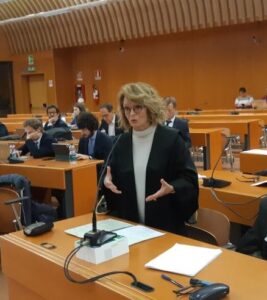
Per appurare la reale consapevolezza dell’imputato, si è analizzata la condotta nel decennio tra il 1976 e il 1986, quando era a capo di Eternit, ma non solo: anche in quello che ha fatto dopo sono stati individuati indicatori della sua personalità che aiutano, secondo i legali, a comprendere il motivo delle decisioni nel «prima». E, non di meno, si è focalizzata la sua storia personale.
Chi è, chi era Stephan Schmidheiny? «Un brillante studente e poi laureato in Giurisprudenza che, pertanto, aveva conoscenza delle norme» ha spiegato D’Amico. «Una persona erudita – ha aggiunto Maurizio Riverditi -, che, in più, è seduto ai tavoli internazionali dove si sa bene perché e in quali Paesi l’amianto è vietato o più contrastato». Ancora: «E’ cresciuto in una famiglia – ha incalzato D’Amico – di milionari… o forse non basta… come si dice? bilionari? Be’, comunque, in una famiglia in cui, già da ragazzo, anche a tavola, sente parlare del mondo industriale gestito a livello internazionale». In Italia, controllava i due terzi del mercato amiantifero.
Con questo bagaglio di conoscenze, anche sperimentate sul campo (è stato direttore vendite delle aziende di famiglia e ha fatto gavetta in stabilimenti Eternit in America Latina, prima del 1976, dal momento che era destinato a lui il comparto dell’amianto, mentre il fratello Thomas avrebbe ereditato il settore del cemento), Stephan Schmidheiny convoca, a giugno 1976, «quel famoso, orribile convegno di Neuss», così lo definisce Riverditi, dove, dopo aver illustrato ai massimi dirigenti del gruppo che cosa si sa scientificamente dell’amianto, della sua nocività e del cancro che sviluppa, «tocca l’eterno dilemma esistenziale, ossia l’interrogativo shakespeariano “To be or not To be”» ha ricordato Riverditi. Esistere o non esistere. Continuare a produrre con l’amianto (impedendo che i rischi siano conosciuti dai lavoratori e dalle popolazioni perché questo porterebbe alla chiusura delle fabbriche) o cessare l’attività che impiega la fibra.
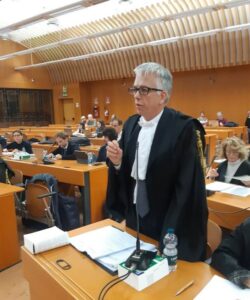
Schmidheiny non cessa. E qui si inserisce l’interrogativo sollevato dal legale di parte civile: «Possiamo chiedere ai giudici di valutare come dolosa la morte di tutte quelle persone?». Riverditi ha spiegato: «Siamo abituati a ragionare sul caso più frequente di omicidio: prendo un’arma, sparo a una persona e la uccido. Ma ci sono altre modalità per configurare l’omicidio doloso (cioè volontario, ndr): se ho il dubbio che il mio comportamento, quale che sia, può cagionare la morte (o più morti) e comunque vado avanti, anche in questo caso c’è il dolo. Non importa – ha precisato – che si siano viste in faccia, a una a una, quelle persone (qui 392): con il mio comportamento, voluto, ho cagionato la morte di esseri umani, poco conta il viso, l’identità».
Sì, va bene, ma come si fa a provare il dolo, cioè «entrare nella testa dell’imputato per sapere se Schmidheiny ha agito col dubbio di provocare quelle morti?».
Da qui l’analisi meticolosa della condotta.
Anche perché non va dimenticato che fino al 1992 l’impiego dell’amianto era consentito dalla legge. «Sì, nessuno dice il contrario – ha stoppato Laura D’Amico –, ma non poteva lavorarlo così!» redarguisce.
C’erano regole ben precise cui attenersi. «Ad esempio, i Dpr 547 del 1955 e Dpr 303 del 1956, che ruotavano intorno a tre figure centrali: il datore di lavoro, il lavoratore e quello che all’epoca si chiamava medico di fabbrica. Era un sistema perfetto già negli anni Cinquanta» ha spiegato l’avvocata D’Amico. E che cosa prevedeva? «Il datore di lavoro doveva prestare la massima attenzione alle misure di protezione; in questo caso specifico primaria protezione dalla polverosità d’amianto, e imponeva l’abbattimento, alla fonte, del rischio. Solo quando, ricorrendo ai più efficienti strumenti tecnologici si fossero raggiunti i maggiori risultati possibili di abbattimento delle polveri, in caso di minimo residuo di polverosità si ricorreva ai “mezzi sussidiari”, ad esempio le mascherine». Quelle adottate da un certo momento in poi all’Eternit, in verità, a detta dello stesso Robock (lo scienziato di Schmidheiny), non erano protettive ma avevano «soltanto un effetto psicologico», cioè l’illusione di proteggersi.
Inoltre, «il datore di lavoro doveva informare adeguatamente i lavoratori sui rischi cui erano esposti e su come prevenirli. Non un’informazione generica! Non il bollettino infilato nella busta paga in cui si richiama, in neretto, il pericolo del fumo, tacendo o minimizzando quello vero della associazione con la polvere d’amianto!».
E sempre quelle normative di oltre sessant’anni fa prevedevano «l’obbligo della prevenzione sanitaria: il datore di lavoro – ha spiegato D’Amico – doveva sempre tenere sotto controllo le condizioni di salute dei lavoratori». Di più: «La Cassazione è sempre stata categorica: in un’azienda o si adottano provvedimenti precisi per eliminare il rischio o si chiude. Non si può mettere in pericolo la vita dei lavoratori».
L’avvocata ha richiamato il convegno di Neuss, considerato un evento cruciale nella condotta dell’imputato: «Schmidheiny, già nel 1976, ha spiegato compiutamente tutte le potenzialità lesive e i rischi dell’amianto, con le previsioni di incremento di mesoteliomi, ha citato gli studi condotti negli anni Cinquanta e Sessanta e ha concluso sottolineando che occorreva attenzione nel lavorare l’amianto». Voleva dire che si sarebbe impegnato per interpretare al massimo livello quelle norme dei Dpr 547 e 303?
«Macché. Parole false. Pochi mesi dopo è stato prodotto Auls 76, il vademecum emanato dall’alto con l’indicazione di tutti i comportamenti da tenere per evitare che si diffondesse la conoscenza di quei rischi». Laura D’Amico inserisce un interrogativo: «E’ forse per imperizia (… non era altezza…), imprudenza (…è stato incauto…), negligenza (… non aveva voglia…), cioè gli elementi che caratterizzano l’omicidio colposo, che ha agito? No! Schmidheiny sapeva».
Un richiamo è stato fatto alle «266 prescrizioni da parte dell’Ispettorato del Lavoro di cui 67 per la polverosità: ogni prescrizione – ha ricordato l’avvocata – è una violazione della legge e ogni violazione della legge è un reato. Siamo a livelli inimmaginabili!».
E dopo? Dopo che l’Eternit fallisce nel 1986 (evento deciso segretamente e preordinato già nel 1983 a Zurigo, perché il settore stava progressivamente perdendo appeal) qual è stata la condotta dell’imprenditore svizzero? E’ stata analizzata per ricavare prove sull’elemento soggettivo dell’imputato: «Se il comportamento successivo è di mistificazione e di nascondimento cercato ad arte (con il ricorso al comunicatore Guido Bellodi), allora quella condotta successiva ha un significato per valutare anche quella tenuta tra il 1976 e il 1986 (il periodo di cui si occupa il processo Eternit Bis, ndr) ».
«Nel timore che si potessero scoprire le conseguenze del suo comportamento durante il lungo periodo del decennio, si è adoperato per mettersi al riparo in modo che quegli eventi non fossero collegati a lui» ha puntualizzato Riverditi. «Dopo circa un anno e mezzo che lo stabilimento è stato chiuso, ha messo dei soldi per una transazione». Con che vincoli? «Nella transazione è scritto chiaramente: che fosse messa la parola fine rispetto a qualsiasi azione legale non solo derivante dal danno subito, ma anche dalle modalità di produzione e dal materiale impiegato». In altre parole: «Lascia lo stabilimento in condizioni disastrose, abbandona i luoghi al proprio destino in modo consapevole, ma, affinché non si risalga a lui, paga qualcuno che lo scolleghi da quei fatti. Schmidheiny è scappato e si è nascosto. Ebbene, il “dopo” dice molto sul comportamento del “prima”!». La conclusione del legale di parte civile è che «l’imputato ha compiuto una scelta razionale: si è confrontato con quel dubbio, l’ha visto in faccia e, nonostante questo, ha agito cercando di nascondere la realtà. Ma – ha concluso con fiducia – quel che non è riuscito a nascondere è la verità!».
2 – La validità delle diagnosi
L’avvocato Giacomo Mattalia è partito da considerazioni sulle «linee guida» in tema di diagnosi del mesotelioma, elaborate da esperti e accreditate dalla letteratura scientifica, che, però, «sono inevitabilmente soggette ad aggiornamenti». Per questo, le linee guida non sono imposte, ma «raccomandate», lasciando spazio alla valutazione dell’anatomopatologo.
E veniamo, nello specifico, all’immunoistochimica, «una tecnica introdotta dall’inizio degli anni Novanta», e progressivamente affinata con nuovi marcatori.
«E prima? – si è interrogato Mattalia – Prima le diagnosi non si facevano? O non erano corrette? E, quindi, tutto quello che è stato fatto in precedenza cade nel nulla? Inclusi, ad esempio, gli studi di Wagner e di Selikoff, perché sarebbero basati su diagnosi non valide?».
Ha parlato delle modalità con cui viene fatta a livello ospedaliero una diagnosi di mesotelioma, frutto di un accurato approccio multidisciplinare. «Non c’è un unico specialista che es
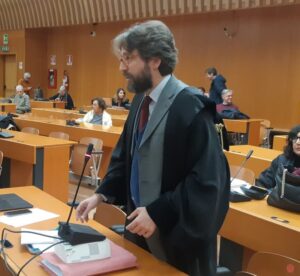
amina il materiale biologico al microscopio! Si confrontano l’oncologo, il radiologo, l’anatomopatologo, il chirurgo toracico e altri, considerando tutti gli esami disponibili: lastre, vetrini, biopsia». Con quale scopo? «Formulare una diagnosi precisa a fini terapeutici. E quella diagnosi, ritenuta validissima per curare una persona, oggi in tribunale viene messa in discussione!». Analoga considerazione era stata espressa dalla pm Mariagiovanna Compare. Nel processo, le 392 diagnosi, frutto di indagini prima ospedaliere, sono state ancora riviste e aggiornate dai consulenti della procura, per arrivare a valutazioni di certezza o probabilità, ma «la probabilità è stata valutata nel complesso del quadro clinico. Non ci si è fermati a una risposta di accademica incertezza!».
«Saremmo contenti noi casalesi che quelle diagnosi fossero state sbagliate, che non fossero stati mesoteliomi – ha chiosato l’avvocata Esther Gatti -, perché ci sarebbe stata più speranza di vivere!».
3 – La posizione degli enti
Il Comune di Casale Monferrato. La Corte d’Assise di primo grado ha condannato l’imputato a pagare una provvisionale di 50 milioni di euro. Che i legali di Schmidheiny contestano. E l’avvocato di parte civile Esther Gatti difende.
Per inciso, tra i comportamenti dell’imputato stigmatizzati dall’avvocata Laura D’Amico, uno riguarda anche i risarcimenti alle vittime: «La Corte d’Assise di Novara lo ha condannato a pagare alle parti civili delle provvisionali (una sorta di acconto) che sono immediatamente esecutive, cioè l’imputato condannato era obbligato a pagarle. Ebbene, non l’ha fatto, non ha neppure osservato la sentenza della Corte!».
Riprende l’avvocata Gatti: «Delle 392 vittime del processo, 330 sono esposti ambientali: persone che nello stabilimento non hanno mai messo piede, ma si sono ammalate e sono morte per il mesotelioma causato dall’amianto». E’ stato possibile perché «la commistione tra stabilimento e territorio cittadino era costante». E perché, secondo l’
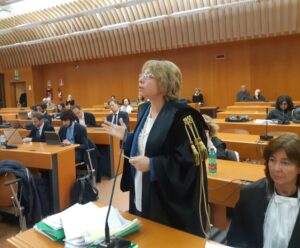
accusa e le parti civili, proprio le mancate precauzioni adottate dal datore di lavoro hanno avuto gravi ripercussioni anche all’esterno. Tra i vari argomenti, si insiste su quello degli indumenti da lavoro impolverati indossati e portati fuori dalla fabbrica, mancando all’interno una lavanderia o anche solo degli armadietti in cui separare abiti civili da quelli di lavoro, che quindi venivano poi lavati a casa: «Una pratica terribile – ha commentato l’avvocata Gatti -, che ha mandato a morte molte donne e famigliari degli operai!». Quanto al polverino, «abbiamo sentito dire che con l’avvento di Schmidheiny c’era stata una diffida a distribuirlo all’esterno. A parte che di questa diffida non si è trovata traccia documentale, ma si sono fatti controlli perché l’ordine fosse rispettato? E qualcuno ha informato le autorità cittadine perché attivassero un’attività di controllo e prevenzione? No, le autorità non sapevano nulla». E quando poi lo stabilimento e altri siti sono stati abbandonati in quello stato, «il Comune di Casale ha dovuto sopperire alla inattività dell’imputato, bonificando i luoghi per cercare di salvaguardare le vite umane».
Quanto alla costituzione di parte civile da parte di altri Comuni del circondario, Esther Gatti ha ricordato «il rischio di esposizione evidenziato dai consulenti della procura fino a un raggio di 11 chilometri»
La Provincia di Alessandria. L’avvocato Alberto Vella ha richiamato la mission dell’ente: «Promuovere la qualità della vita delle persone. Qui è stata addirittura tolta la vita, è stato compromesso, cioè, quel bene primario che la Provincia deve salvaguardare».
La Regione Piemonte. L’avvocato Alessandro Mattioda ha chiesto che la Corte d’Assise confermi la condanna inflitta in
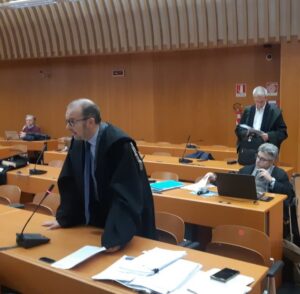
primo grado all’imputato a risarcire all’ente i danni, patrimoniali e no, da liquidare in separata sede.
L’Avvocatura dello Stato, per conto della Presidenza del Consiglio dei ministri: «I cittadini morivano mentre l’imputato si arricchiva. Se non è questa una sofferenza per il territorio che lo Stato deve tutelare!».
B – I DIFENSORI
4 – La trascrizione degli atti
L’avvocato Alleva ha ribadito un tema già affrontato in altre sedi, tra le questioni preliminari: la corretta traduzione degli atti nella lingua dell’imputato che, a parere della difesa, non è stata rispettata. «La traduzione del capo di imputazione è incomprensibile e pure monca in una parte importante che riguarda il dolo».
5 – Accesso ai vetrini
Il difensore ha evidenziato le difficoltà di accesso ai vetrini in cui sono conservati i campioni di tessuto biologico delle vittime, vetrini che, «in questo processo – ha sottolineato Alleva -, rappresentano il corpo del reato e sono indispensabili per svolgere l’attività di controllo delle diagnosi, tanto più che, secondo alcuni scienziati, il mesotelioma è un “tumore camaleonte”, cioè imita altri tumori. Quindi era giusto e indispensabile poter svolgere una accurata verifica in ambito anatomopatologico alla luce degli innovativi criteri diagnostici». Compito che la difesa ha affidato all’anatomopatologo Massimo Roncalli. I tempi incidentati e lunghi di accesso, però, sanati poi dalla Corte d’Assise di primo grado, hanno rappresentato, secondo Alleva, «una violazione del diritto di difesa».
6 – Ne bis in idem
Non si può giudicare due volte un imputato per lo stesso fatto. Sulla questione del «ne bis in idem» è intervenuto l’avvocato Di Amato, richiamando in particolare i casi di vittime che sono elencati tra i 392 di questo processo ma erano già contenuti nel capo di imputazione del Maxiprocesso Eternit 1. La Corte Costituzionale, già interpellata a suo tempo, aveva superato la questione escludendo l’impasse. Ma «quella decisione non ci convince – ha detto il difensore –. Pensate quale sarebbe il principio della libera circolazione europea se ogni giudice desse una propria interpretazione del “bis in idem”!». Da qui la richiesta di «sottoporre la questione alla Corte di Giustizia dell’Unione Europea, altrimenti non c’è rispetto del diritto» ha ammonito.
7 – La decisione del gup di Torino
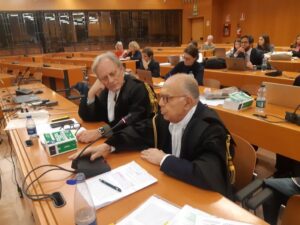
«L’imputato aveva diritto a essere processato da un giudice di Vercelli e invece è stato giudicato dalla Corte d’Assise a Novara», a dire che doveva essere giudicato per omicidio colposo e non volontario (con dolo eventuale). Qual è il significato di questa affermazione del difensore Di Amato? La genesi del tema risale all’udienza preliminare di Torino, al termine della quale il gup Federica Bompieri aveva riqualificato il reato da omicidio doloso (contestato dalla procura) in colposo aggravato; come conseguenza, il fascicolo, che riguardava vittime di Casale, di Cavagnolo, di Bagnoli, di Rubiera dell’Emilia era stato spacchettato in quattro filoni. Ciascuno era stato inviato alla magistratura competente per territorio. Il filone casalese era finito alla procura di Vercelli che (come anche quella di Napoli per i morti di Bagnoli) aveva svolto ulteriori indagini e rinnovato al gup di Vercelli la richiesta di rinvio a giudizio di Schmidheiny per omicidio doloso (richiesta che il gup aveva accolto, mandando a processo l’imprenditore svizzero in Corte d’Assise a Novara). Secondo l’avvocato Di Amato non lo poteva fare: «A nostro parere, era precluso al pm di Vercelli modificare il capo di imputazione, disattendendo la decisione di un giudice precedente, cioè il gup di Torino che aveva sentenziato la riqualificazione del reato da doloso a colposo». La Corte d’Assise di Novara aveva già replicato a questa eccezione, riconoscendo la libertà del nuovo pm di procedere come ha fatto, integrando l’attività investigativa con nuove indagini. Invece, il difensore Di Amato nega questa totale libertà di manovra e insiste: «Il pubblico ministero aveva due possibilità: poteva chiedere l’archiviazione oppure doveva mantenere la stessa impostazione del giudice Bompieri».
C – FLASH MOB FUORI DAL TRIBUNALE
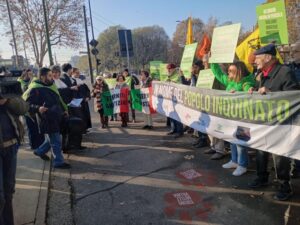
«Ecogiustizia subito: in nome del popolo inquinato»: è il titolo della campagna nazionale promossa da Acli, Agesci, Arci, Azione Cattolica Italiana, Legambiente e Libera, cui si è unita Afeva, finalizzata a riaccendere l’attenzione su luoghi simbolo dell’inquinamento e dell’ingiustizia ambientale. L’avvio della campagna si è concentrato sul «caso Casale», con due eventi che si sono svolti mercoledì 29 novembre. Al mattino, un flash mob davanti al Palazzo di giustizia di Torino, dove era in corso la terza udienza del processo Eternit Bis in Corte d’Assise d’Appello: un gruppo di attivisti dell’«Associazione famigliari e vittime amianto», tra cui diversi famigliari dei morti di mesotelioma, ha preso parte alla manifestazione. Nel pomeriggio, al salone Tartara di Casale si è svolta un’assemblea pubblica al termine della quale è stato siglato un Patto di Comunità per l’Ecogiustizia nel «Sin (Sito d’interesse nazionale) di Casale Monferrato», contenente proposte per sollecitare gli interventi che ancora mancano, verificarne l’attuazione e incentivare la partecipazione attiva delle popolazioni ai progetti di transizione ecologica del territorio. Piero Comba, tra i maggiori esperti italiani sugli impatti sanitari dell’amianto, ha proposto un gemellaggio tra Casale Monferrato e Sibatè, una cittadina di 38 mila abitanti, a una trentina di chilometri circa da Bogotà, in Colombia, dove uno studio internazionale ha identificato un’area ad alta incidenza di inquinamento da amianto e di malati di mesotelioma pleurico.
D – «AMBIENTALISTA DELL’ANNO»
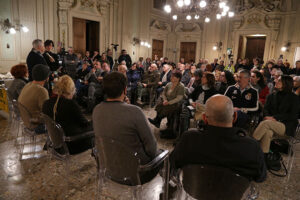
È stato assegnato a Cecilia Di Lieto, storica voce di Radio Popolare, il Premio «Luisa Minazzi – Ambientalista dell’anno», alla XV edizione. La cerimonia di consegna del Premio – promosso da Legambiente e dalla rivista La Nuova Ecologia insieme al Comitato organizzatore che unisce numerose realtà casalesi, all’Ente di Gestione delle Aree Protette del Po piemontese e al Comune monferrino – si è svolta venerdì 29 novembre nella sala consiliare di Palazzo Sangiorgio, a Casale Monferrato. In tanti anni di passione e lavoro a Radio Popolare, Cecilia Di Lieto si è occupata di numerose tematiche. Dal 2014, dal lunedì al venerdì va in onda, dalle 12,45 alle 13,15, con il programma radiofonico «Considera l’armadillo», che racconta l’affascinante e complesso rapporto tra l’uomo e gli altri animali. Di Lieto è anche autrice del libro «Me l’ha detto l’armadillo. Storie di passione tra noi e altri animali», Altreconomia editore.
Il Premio, che dal 2012 è intitolato a Luisa Minazzi, morta nel 2010 di mesotelioma a soli 57 anni, dopo una vita spesa in trincea a difesa dell’ambiente come direttrice didattica, attivista e amministratrice comunale, punta a valorizzare persone impegnate per il benessere della comunità, la diffusione del messaggio ambientale, l’innovazione d’impresa, la salvaguardia del territorio. Questa XV edizione del Premio ha accomunato al nome di Luisa Minazzi anche quello di Romana Blasotti Pavesi, storica presidente, per trent’anni, dell’associazione Afeva, morta a settembre all’età di 95 anni.
Oltre a Cecilia Di Leo, gli altri testimoni di quell’Italia preziosa delle virtù civiche della XV edizione del Premio Ambientalista dell’Anno sono stati: Acs, che opera in vari paesi per lo sviluppo sostenibile, l’abbattimento delle diseguaglianze e l’equità di genere e che ha ideato GazaWeb per attivare sistemi di comunicazione stabile a Gaza; Fiorella Belpoggi, biologa, emerita direttrice scientifica dell’Istituto Ramazzini di Bologna fondato nell’87 dal professor Maltoni, oncologo di fama mondiale; Giovanni Chimienti, biologo marino, ricercatore in Ecologia all’Università di Bari e National Geographic explorer; Igor D’India, videomaker specializzato in spedizioni avventurose e tematiche ambientali che ha documentato la presenza di grandi quantità di rifiuti sui fondali dello Stretto di Messina; Giuseppe Giovì Monteleone, sindaco di Carini (Palermo) che si è battuto per le demolizioni delle ville abusive che hanno dato il via al risanamento della fascia costiera.
TRANSLATION BY VICTORIA FRANZINETTI
Mr Schmidheiny, don’t you think the time has come to personally, directly and financially, endeavour to research and find a treatment for mesothelioma? For you it would be a serious philanthropic choice and a formidable image boost. For thousands of people around the world it would be healing and life!
ETERNIT BIS APPEAL OF ASSIZES HEARING
27 NOVEMBER 2024
by Silvana Mossano
On Wednesday 27 November, the third hearing of the Eternit bis trial in the ‘Giuseppe Casalbore’ courtroom of the Turin Court of Justice, the third hearing of the Eternit Bis trial took place before the Court of Appeal, chaired by Cristina Domaneschi, assisted by Eleonora Gallino and the jury (aka popular judges). In the morning, the lawyers for the plaintiffs (parties civiles) spoke. In the afternoon, the defence lawyers for Stephan Schmidheiny, sentenced by the Court of Assizes to 12 years’ imprisonment for aggravated manslaughter began their presentations. The Court of Novara also applied the statute of limitations for 199 cases and acquitted him in 46 cases. The sentence was appealed both by the Public Prosecution (which also requested the renewal of the trial, the Assize Court has not yet ruled) and by the Defence.
The next hearing is scheduled for Wednesday, 4 December: defence counsels Astolfo Di Amato and Guido Carlo Alleva will speak and will continue Wednesday, 11 December. A hearing is also scheduled for 18 December, but the president will consider whether to keep it or set new dates in January.
SUMMARY
A – THE Plaintiffs LAWYERS (parties civiles that is institutions, associations, trade unions and individual citizens) reiterated their request for recognition of the crime of intentional murder (with possible intent) for all the 392 victims indicated in the indictment and contest the acquittals referred to 46 cases of death.
1- The intent and wilfulness due to the following:
– at the time of the facts (i.e. during the decade when Stephan Schmidheiny was head of Eternit)
– after the facts (i.e. during the period following the closure of the plant)
– personal history of the defendant
2 – They stated the validity of the diagnoses, which are the result of the expert opinion of several specialists (pathologists, radiologists, cancer specialists, thoracic surgeons etc)
3 – The position of the authorities (Municipality, Province, Region, central Government)
B – The DEFENNSE addressed, or rather reiterated, some preliminary issues.
4 – Translation of the documents into the defendant’s language
5 – Access to ‘slides
6 – Ne bis in idem (akin to double jeopardy)
7 – The decision of the Turin magistrate for the first hearing: its impact trial
C – FLASH MOB OUTSIDE THE COURT: ‘In the name of the polluted people’.
D – ‘ENVIRONMENTALIST OF THE YEAR’: Luisa Minazzi Award, ceremony in Casale
DETAILED INSIGHTS
A – PLAINTIFFS
1 – wilfulness or intent
‘I know that it is not easy to imagine convicting a global ‘white-collar criminal for wilful offence, as is the case. This is yet another reason why this trial is one of a kind: it is unique because of the number of victims, the amount of material that the prosecution has patiently gathered (documents, testimonies, consultant reports) for the original trial, the Eternit 1 Maxi-trial where the defendant was charged with intentional environmental disaster, while in the present trial he is charged with murder: 392 people. 392 dead‘. Thus began lawyer Laura D’Amico, one of the plaintiff’s lawyers in all the Eternit trials.
Lawyer Laura D’Amico
The defendant’s conduct in the decade between 1976 and 1986, when he was head of Eternit, was analysed, and what he did afterwards, all indicators of his personality were identified to help understand the reason for his decisions
Who is, who was Stephan Schmidheiny? ‘A brilliant student and then a law graduate who, therefore, had knowledge of the rules,’ explained D’Amico. A scholar,’ added Maurizio Riverditi another plaintiff’s lawyer, ‘ who, moreover, sat at international tables where it is well known why and in which countries asbestos was banned or most opposed’. Again: ‘He grew up in a family,’ D’Amico continued, ‘ of millionaires… or maybe that’s not enough…, billionaires? Well, anyway, in a family in which, even as a boy, he heard about the internationally managed industrial world at the dinner table‘. In Italy, he controlled two thirds of the asbestos market.
He had great knowledge, and experience in the field: he had been sales manager of the family companies and had worked his way up through the ranks in Eternit plants in Latin America, before 1976, since he had been left the asbestos sector, while his brother Thomas was to inherit the cement side of the business. In June 1976, Stephan Schmidheiny convened, ‘that famous, horrible conference in Neuss’, as Lawyer Riverditi defined it, where, after illustrating to the group’s top executives what was scientifically known about asbestos, its harmfulness and the cancer it causes, he ‘touches on the eternal existential dilemma, the Shakespearean question “To be or not to be”’. To exist or not to exist. To continue producing with asbestos (preventing the risks from being known to workers and populations because this would lead to the closure of factories) or to cease the activity using the fibre.
Lawyer Maurizio Riverditi
Schmidheiny decided to continue. And this is where the question raised by the plaintiff’s lawyer: ‘Can we ask the judges to assess the death of all those people as intentional? ‘We are used to reasoning on the most frequent case of murder: I take a weapon, shoot a person and kill him. But there are other ways of defining wilful murder (i.e. voluntary,): if I have the doubt that my behaviour, whatever it may be, can cause death (or more deaths) and I go ahead anyway, even in this case there is intent. It doesn’t matter,’ he pointed out, “that one by one, those 392 people died due to his intentional, behaviour, he caused the death of human beings, little did their identity matter”.
The question remains as to how one proves wilful intent, that is, ‘getting inside the defendant’s head to know whether Schmidheiny acted with the doubt of causing those deaths?’
Hence the meticulous analysis of the conduct. Not forgetting that until 1992 the use of asbestos was permitted by law, a fact that no one denies -adds lawyer D’Amico. However, even before there were precise rules to follow. ‘For example, Presidential Decree 547 of 1955 and Presidential Decree 303 of 1956, which revolved around three central figures: the employer, the worker and what was then called the factory doctor. It was a perfect system back in the 1950s,’ And what did it involve? ‘The employer had to pay the utmost attention to protective measures; in this specific case, primary protection from asbestos dust, and imposed the abatement, at source, of the risk. Only when, by resorting to the most efficient technological instruments, the greatest possible dust abatement results had been achieved, in the event of the slightest residual dustiness, was recourse made to ‘subsidiary means’, e.g. masks’. Those adopted from a certain point onwards at Eternit, according to Dr Robock (Schmidheiny’s scientist), were not protective but had ‘only a psychological effect’, i.e. the illusion of protection. Moreover, ‘the employer had to inform the workers adequately about the risks they were exposed to and how to prevent them. Not generic information! Not the bulletin tucked into the pay slip in which the danger of smoking is recalled, in bold type, while keeping silent or minimising the real danger of its association with asbestos dust! And again, those regulations of over sixty years ago provided for ‘the obligation of health prevention: the employer,’ explained D’Amico, ‘had to keep the workers’ health conditions under control at all times. What’s more: ‘The Supreme Court has always been categorical: in a company, either precise measures are taken to eliminate the risk or the plant had to close. You cannot put workers ‘lives at risk’. Lawyer D’Amico also recalled the Neuss conference, which was considered a crucial event in the defendant’s conduct: ‘Schmidheiny, as early as 1976, fully explained all the damaging potential and risks of asbestos, with forecasts of an increase in mesotheliomas, cited studies conducted in the 1950s and 1960s, and concluded by emphasising that care was needed when working with asbestos’. Did he mean that he would strive to interpret those regulations of Presidential Decree 547 and 303 to the highest level? ‘Not at all. False words. A few months later, Auls 76 was produced, the handbook issued from above with the indication of all the behaviours to be kept in order to avoid spreading knowledge of those risks‘. Laura D’Amico asked a question: ‘Was it inexperience, foolishness (… he was careless…), negligence (… he did not feel like it…), that is, the elements that characterise manslaughter, that he acted? No! Schmidheiny knew‘.
A reminder was made of the ‘266 reports by the Labour Inspectorate of which 67 for excessive dusts: every report,’ the lawyer recalled, ‘ was a violation of the law and every violation of the law is a crime. We are at unimaginable levels!‘.
And after that? After Eternit went bankrupt in 1986 (an event secretly decided and pre-ordained as early as 1983 in Zurich, because the material was gradually losing appeal) what was the Swiss entrepreneur’s conduct? It was analysed in order to obtain evidence on the subjective element of the defendant: ‘If the subsequent conduct is one of mystification and concealment artfully sought (with the use of the PR Firm Guido Bellodi), then that subsequent conduct has a significance for assessing also the conduct held between 1976 and 1986 (the period covered by the Eternit Bis trial, ed.) ’. ‘Fearing that the consequences of his conduct during the long period of the decade might be discovered, he took steps to take cover so that those events would not be linked to him,’ Lawyer Riverditi pointed out. ‘After about a year and a half that the plant was closed, he put up money for a settlement with the workers’. With what constraints? ‘The settlement clearly stated: that there would be an end to any legal action not only arising from the damage suffered, but also from the production methods and the material used. In other words: ‘He left the plant in disastrous conditions, he consciously abandoned it to its fate, but, so that it could not be traced back to him, he paid someone to take the fall: Schmidheiny ran and hid. Well, the ‘after’ says a lot about the behaviour of the ‘before’!’. The conclusion of the plaintiff’s lawyer is that ‘the defendant made a rational choice: he was confronted with that doubt, he saw but despite this, he acted by trying to hide facts. But,’ he concluded confidently, ’ what he failed to hide was the truth!
2 – The validity of the diagnoses
Lawyer Giacomo Mattalia started from the ‘guidelines’ on the mesothelioma diagnoses, drawn up by experts and accredited by the scientific literature, which, however, ‘are inevitably subject to time and methods have been updated. Guidelines are not imposed, but ‘recommended’, leaving room for the pathologist’s assessment. This leads us to immunohistochemistry, ‘a technique introduced since the early 1990s’, and progressively refined with new markers. ‘And what about before that? – wonders Mattalia – Were diagnoses not performed before then? Or were they incorrect? And, therefore, is everything that was performed previously appear not to be valid? Including, for example, Wagner’s and Selikoff’s studies?‘ He spoke of the way in which a diagnosis of mesothelioma is made at hospital level, the result of a careful multidisciplinary approach. […]
Lawyer Giacomo Mattalia
Oncologists, radiologists, pathologists, chest surgeons and considering all the available examinations: X-rays, slides, biopsy‘. With what aim? ‘To formulate an accurate diagnosis for therapeutic purposes. And why is a diagnosis considered valid when treating a person, being questioned in court today!‘. A similar consideration was expressed by public prosecutor Dr Mariagiovanna Compare. In the trial, the 392 diagnoses, which were the result of investigations first carried out in hospitals, were still reviewed and updated by the prosecutor’s consultants, to arrive at assessments of certainty or probability, but ‘the probability was assessed in the overall clinical picture. It did not stop at an answer of academic uncertainty!’ ‘as Casalesi (people from Casale) we would be happy if those diagnoses had been wrong, if they had not been mesotheliomas,’ said lawyer Esther Gatti, ‘ because there would have been more hope of living!
3 – The position of the authorities
The Municipality of Casale Monferrato. The Court had sentenced the defendant to pay an interim payment of EUR 50 million. Which Schmidheiny’s lawyers dispute and did not pay.
The defendant’s behaviour stigmatised by lawyer Laura D’Amico, also concerns compensation to victims: ‘The Novara Assize Court sentenced him to pay interim compensation to the plaintiffs that are immediately enforceable, i.e. the sentenced defendant was obliged to pay them. Well, he did not do so, he did not even comply with the Court’s ruling!’ Lawyer Gatti resumed: ‘Of the 392 victims in the trial, 330 are community cases: people who never set foot in the plant but became ill and died of mesothelioma caused by asbestos’. This was possible because ‘the plant and the city territory being so closely intertwined.
lawyer Esther Gatti
According to the PPs and plaintiffs’ lawyers, it was precisely the employer’s failure to take precautions that had serious repercussions outside the plant. Among the various arguments, one is that dusty work overalls were not washed inside the plant but taken home, lacking a laundry or even lockers inside to separate civilian clothes from work clothes: ‘A terrible practice,’ commented Lawyer Gatti, ‘ that sent many women and workers’ families to their death! As for the dust, ‘we heard that with the advent of Schmidheiny there had been a warning against the use of asbestos outside. There is no documentary evidence of this warning, but were checks carried out to ensure that the order was respected, Did anyone inform the city authorities so that they could have controlled and prevented? No, the authorities knew nothing‘. And when the plant and other sites were abandoned in that state, ‘the municipality of Casale had to make up for the defendant’s inactivity by reclaiming the sites to try to safeguard human lives’.
As for the other municipalities in the surrounding area, Esther Gatti recalled ‘the risk of exposure highlighted by the prosecutor’s consultants up to a radius of 11 kilometres’. Alberto Vella, the lawyer for the Province of Alessandria. recalled the body’s mission: ‘To promote people’s quality of life. Here even lives have been taken, that is, the primary good that the Province must safeguard has been compromised‘.
Lawyer Alessandro Mattioda for the Region Piedmont. asked the Assize Court to confirm the Lawyer Alberto Vella
lower court’s sentence to compensate the entity for monetary and moral damages, to be settled in separate proceedings. The State Lawyers, on behalf of the Council of Ministers: ‘Citizens died while the defendant got rich. If this is not suffering for the territory that the State must protect!’.
B – THE DEFENCE
4 – The transcript
Advocate Alleva reiterated an issue already addressed elsewhere among the preliminary issues: the correct translation of the acts into the language of the defendant, which, in the defence’s opinion, was not respected. ‘The [German] translation of the indictment is incomprehensible and even incomplete in an important part that concerns intent’.
5 – Access to the slides
The defence lawyer pointed out the difficulties of access to the slides in which the victims‘ biological tissue samples are kept, slides that, “in this trial,” Alleva stressed, “ represent the body of the crime and are indispensable for carrying out the activity of checking the diagnosis, especially since, according to some scientists, mesothelioma is a ”chameleon tumour’, i.e. it imitates other tumours. It was therefore right and indispensable to be able to carry out an accurate anatomopathological examination in the light of the innovative diagnostic criteria‘. A task that the defence entrusted to pathologist Dr Massimo Roncalli. The incidental and lengthy access time, however, later remedied by the Court of First Instance, represented, according to Alleva, ‘a violation of the right of defence’.
6 – Ne bis in idem (Double Jeopardy)
A defendant cannot be tried twice for the same fact. Lawyer Di Amato intervened on the issue of ‘ne bis in idem’, referring to the cases of victims that are listed among the 392 of this trial but were already contained in the indictment of the Eternit 1 Maxi-trial. The Constitutional Court bypassed the issue by ruling it out. However ‘that decision does not convince us,’ said the defence. ‘Just think what the principle of European freedom of movement would be if each judge gave his/her own interpretation of bis in idem! Hence the request to ‘submit the matter to the Court of Justice of the European Union, otherwise there is no respect for the law,’ he warned.
7 – The decision of the Turin Judge of the First hearing (aka GUP)
From left, lawyer Guido Carlo Alleva and lawyer Astolfo Di Amato: the defendant’s defence attorneys presented some preliminary issues. They will continue on Wednesday 4 and 11 December
‘The defendant was entitled to be tried by a judge in Vercelli and instead he was tried by the Assize Court in Novara’, meaning that he should have been tried for manslaughter and not voluntary manslaughter (with possible intent). What is the meaning of this statement by the defendant Lawyer Di Amato? It goes back to the preliminary hearing in Turin, at the end of which Judge Federica Bompieri downgraded the crime from intentional murder (as requested by the Prosecution) to manslaughter with aggravated circumstances; as a result, the file, which concerned victims from Casale, Cavagnolo, Bagnoli and Rubiera dell’Emilia, was divided into four trials according to the area. The Casale case ended up in Vercelli, which (like the Naples public PP for the Bagnoli deaths) carried out further investigations and renewed the request for wilful murder, a request granted, sending the Swiss entrepreneur to trial in the Novara Assize Court). According to defence Lawyer Di Amato, he could not do so: ‘In our opinion, the Vercelli prosecutor was precluded from modifying the charge, disregarding the decision of a previous judge, i.e. the gup of Turin, which had ruled that the crime should be redefined as manslaughter’. Defence lawyer Di Amato disagreed and insisted: ‘The public prosecutor had two options: he could ask for the case to be dismissed or he had to maintain the same approach as Judge Bompieri.
C – FLASH MOB OUTSIDE THE COURT
Flash Mob ‘In the name of the polluted people’ on Wednesday 27 November in Turin, in front of the Palace of Justice, with the participation of Afeva activists from Casale
‘Ecogiustizia subito: in nome del popolo inquinato’ (Justice now: in the name of the polluted people): this is the title of the national campaign promoted by Acli, Agesci, Arci, Azione Cattolica Italiana, Legambiente and Libera, joined by Afeva, aimed at rekindling attention on places symbolic of pollution and environmental injustice. The launch of the campaign focused on the ‘Casale case’, with two events taking place on Wednesday 29 November. In the morning, a flash mob in front of the Courts in Turin, where the third hearing of the Eternit Bis trial in the Court of Appeal was underway: a group of activists from the ‘Associazione famigliari e vittime amianto’ (Association of Asbestos Victims and Families), including several relatives of mesothelioma victims, took part in the demonstration. In the afternoon, a public meeting was held in Casale’s Tartara Hall, at the end of which a Community Pact for Ecological Justice in the ‘Sin (Site of National Interest) of Casale Monferrato’ was signed, containing proposals to urge the interventions that are still lacking, to verify their implementation and to encourage the active participation of the populations in the projects for the ecological transition of the territory. Pietro Comba, one of Italy’s leading experts on the health impacts of asbestos, proposed a twinning between Casale Monferrato and Sibatè, a town of 38,000 inhabitants, about thirty kilometres from Bogotà, in Columbia, where an international study has identified an area with a high incidence of asbestos pollution and pleural mesothelioma patients.
D – ‘ENVIRONMENTALIST OF THE YEAR
The audience in the Council Chamber of Palazzo Sangiorgio in Casale Luisa Minazzi award ceremony
Where Cecilia Di Lieto, from Radio Popolare, who was awarded the ‘Luisa Minazzi – Environmentalist of the Year’ Award, in its 15th edition. The award ceremony – promoted by Legambiente and the magazine La Nuova Ecologia together with the organising committee, which unites numerous Casale-based organisations, the Piedmont Po River Po Protected Areas Management Authority and the Monferrato municipality – was held on Friday 29 November in the Council Chamber of Palazzo Sangiorgio, in Casale Monferrato. In many years of passionate work at Radio Popolare, Cecilia Di Lieto has dealt with numerous issues. Since 2014, from Monday to Friday she has been on air, from 12.45 to 13.15, with the radio programme ‘Consider the armadillo’, which talks about the fascinating and complex relationship between humans and other animals. Di Lieto is also the author of the book ‘Me l’ha detto l’armadillo. Stories of passion between us and other animals’, Altreconomia editore.
The Award, which since 2012 has been named after Luisa Minazzi, who died in 2010 of mesothelioma at the age of just 57, after a life spent in defence of the environment as an educational director, activist and local councillor, to valorise people committed to the wellbeing of the community, the dissemination of the environmental message, business innovation and safeguarding the territory. This 15th edition of the Award bears the names of Luisa Minazzi and of Romana Blasotti Pavesi, the past president of the Afeva association for thirty years, who died in September at the age of 95.
In addition to Cecilia Di Leo, the other witnesses of the 15th edition of the Environmentalist of the Year Award were: Acs, which works in various countries for sustainable development, the abatement of inequalities and gender equity and which has devised GazaWeb to activate stable communication systems in Gaza; Fiorella Belpoggi, biologist, emeritus scientific director of the Ramazzini Institute in Bologna founded in 1987 by Professor Maltoni, a world-famous oncologist; Giovanni Chimienti, marine biologist, researcher in Ecology at the University of Bari and National Geographic explorer; Igor D’India, a video-maker specialised in adventure expeditions and environmental issues who has documented the presence of large quantities of waste on the seabed of the Strait of Messina; Giuseppe Giovì Monteleone, mayor of Carini (Palermo) who has campaigned for the demolition of unauthorised villas, which has triggered the redevelopment of the coastal strip.
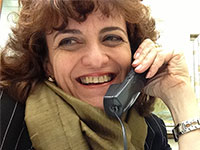
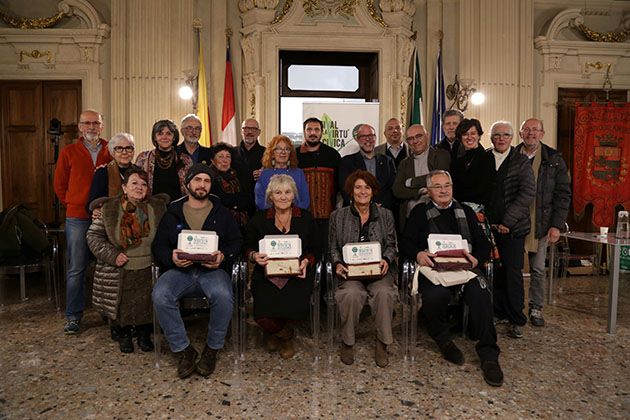
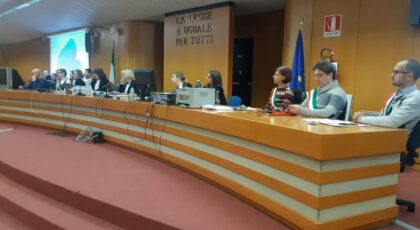
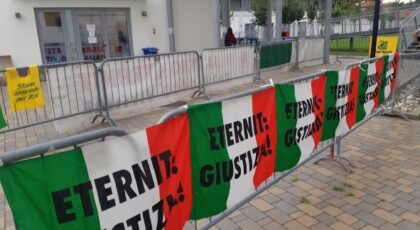
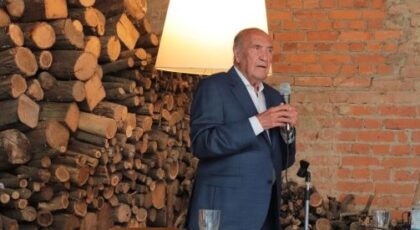
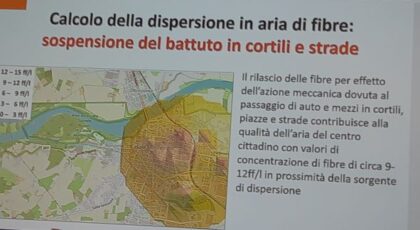
Brava Silvana che documenti e informi su questa sacrosanta battaglia contro i responsabili della pestilenza da amianto.Grazie davvero.
Grazie Silvana. Purtroppo assistiamo ad un film già rivisto. Speriamo cambi il finale !
Grazie Slvana, un riassunto delle espressioni più significative delle Parti Civili veramente molto ben fatto! La verità è dalla nostra parte!
Ci auguriamo che così sia anche nelle conclusioni, sarebbe finalmente ora!!!
Grazie Silvana per il tuo impegno nella lucida cronaca del processo. Leggerti ci porta in aula! Un solo commento: che si impegni per aiutarci a trovare la cura. Solo così avremo pace